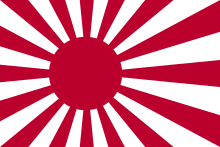Kyokujitsuki
Kyokujitsuki ( Japanese 旭日 旗 , German "Flag of the Rising Sun", English Rising Sun Flag ) is the name of the Japanese military flag . For the Japanese Self-Defense Forces , the navy flag shows 16 red rays with an aspect ratio of 2: 3, that of the army - in origami style - 8 red rays, the sun right in the middle (aspect ratio 5: 6) and a golden border. Due to the atrocities committed by the Japanese in World War II under this flag, it is controversial. The lack of a historical reappraisal of the role of Japan during the Second World War and its responsibility on the official side contribute to the controversial attitude of other peoples towards the use of the Kyokujitsuki. The Kyokujitsuki triggers subliminal memories of the imperial Japanese armed forces and their war crimes in the Pacific War in many peoples of Asia . Outside of Japan, this flag is therefore still considered by many in Asia as a symbol of Japanese imperialism .
history
The Japanese emperors come from a race that derives its power from its origins. The family allegedly descended from the sun goddess Amaterasu . That is why the symbol of the sun soon became the symbol of Japan. Around 1870, when the Meiji government replaced the shogunate , the commanders began to look for a specific war flag, because until then the samurai were the defenders of the country and carried the flags of their respective daimyates .
A little later the motif of the rising sun with rays of the sun was chosen and the armed forces on land and at sea were equipped with it. The flag was first used in the First Sino-Japanese War in 1894–95 .
However, it became known through the Second World War , when the Japanese Empire opened the Pacific War under this flag on July 7, 1937 and the Imperial Japanese Armed Forces were deployed under this flag, in particular through its warships and naval aviators . The motif was also very popular with the Kamikaze pilots and was often painted on the respective aircraft or a small flag was worn as a headband. They were led by the units on land as well as at sea.
present
From 1945 to 1954, Japan had no military forces, so the flag was not used. Since 1954, the warships of the marine self-defense forces have been sailing under this flag again. The army in the form of the ground self-defense forces , however, uses a modified variant.
See also
Web links
- Flags of the World (English)
Individual evidence
- ↑ ariz / Reuters: FLOTTENPARADE - Both Koreas and Japan in dispute over controversial flag. Japan wants to hoist the “flag of the rising sun” at a fleet parade in Jeju, South Korea . Both North and South Korea feel provoked by this. In: www.faz.net . October 5, 2018, accessed May 31, 2019 .
- ↑ Tomomi Yamaguchi: Xenophobia in Action. Ultranationalism, Hate Speech, and the Internet in Japan . In: Radical History Review . 2013, p. 98–118 , doi : 10.1215 / 01636545-2210617 (English, rhr.dukejournals.org [accessed January 18, 2017]).
- ^ JA Mangan, Sun-Yong Kwon & Bang-Chool Kim: London 2012 - Site for Political Animosities: South Korea and Japan in Confrontational Rational 'Irrationality' (Part One: Long Memories) . In: The International Journal of the History of Sport . tape 30 , no. 15 , 2013, p. 1784–1795 , doi : 10.1080 / 09523367.2013.842559 (English, tandfonline.com [accessed January 18, 2017]).
- ↑ Takashi Yoshida: Why do flags matter? The case of Japan. In: China Policy Institute. July 22, 2015, accessed January 18, 2017 .
- ^ Adam Taylor: Japan has a flag problem, too. In: Washington Post . June 27, 2015, accessed January 18, 2017 .


